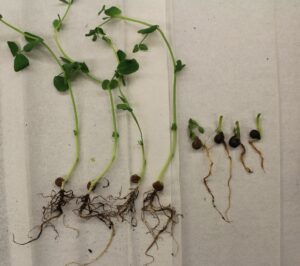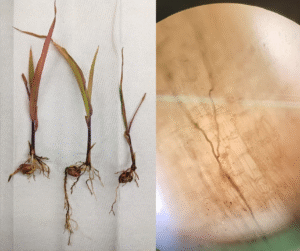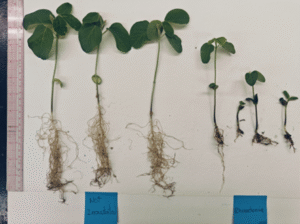Plant Clinic Update – May 2025
The University of Illinois Plant Clinic is an Extension program located in the Department of Crop Sciences. For more information, please see our website: https://extension.illinois.edu/plant-clinic or contact us at 217-333-0519.
Wheat Samples: We have received 3 wheat samples so far in 2025, all from southern Illinois. Bacterial leaf streak, Septoria leaf blotch, and thrips were found on the samples from Marion County, while anthracnose, Fusarium head blight, Septoria leaf blotch, stripe rust, and thrips were found on the sample from Jackson County.
Seedling Disease Samples: In the coming weeks, as field crops germinate and emerge, we anticipate receiving more samples showing signs of seedling diseases. We encourage growers and agronomists to begin scouting—especially after periods of wet weather and in field areas prone to water accumulation, such as low spots or compacted field zones.
When submitting seedling samples for disease and pest diagnosis, please include multiple entire plants, ideally in different stages of infection or development that help our diagnosticians to make a more accurate diagnosis. Be sure to carefully dig up seedlings, including those that haven’t yet emerged. Use a trowel to gently lift plants from the soil to avoid tearing fragile, rotted roots. Pulling plants by hand often leaves key root tissue behind.
Common early-season diseases in soybean and corn in the state of Illinois include Pythium, Phytophthora, Rhizoctonia, and Fusarium. Early detection is key to managing these pathogens effectively.



Herbicide Injury Samples: We also start to receive a lot of suspected herbicide damage samples early in the growing season. As a reminder, the University of Illinois Plant Clinic does not perform testing to confirm the presence or identity of pesticides in plant tissue. We examine the sample to determine if pests or cultural factors may have contributed to or are responsible for the symptomology displayed on the plants. Some insect feeding damage, viral diseases, and adverse growing conditions can cause symptoms similar to injury from various herbicides. We remind everyone to follow the label of any pesticide you apply to reduce the possibility of carryover or unintentional contact. For more information, please see:
https://extension.illinois.edu/sites/default/files/2023-10/plant_herbicide_collateral_damage.pdf
https://extension.illinois.edu/sites/default/files/pc_factsheet_on_pgr_herbicide_injury.pdf
Free Soybean Cyst Nematode Egg Count Samples: The Illinois Soybean Association is funding free SCN egg counts for Illinois growers. We recommend sampling fields currently planted in soybean. Collect samples using a soil probe or shovel. Soil samples need to come from approximately 6 inches below the surface and in the soybean root zone. For more information about sampling, please see: https://extension.illinois.edu/sites/default/files/nematology_submission_guidelines.pdf
When submitting free SCN egg count samples, please use this submission form: https://extension.illinois.edu/sites/default/files/2024-10/free_scn_form_final.pdf





